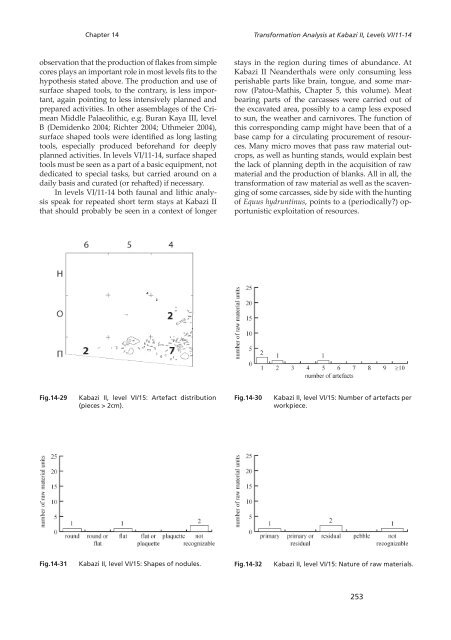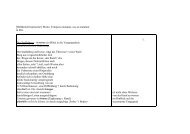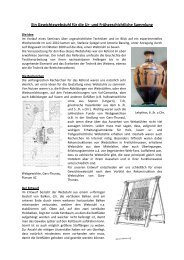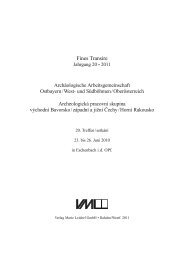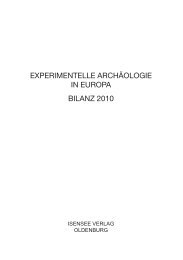Thorsten Uthmeier & Jürgen Richter
Thorsten Uthmeier & Jürgen Richter
Thorsten Uthmeier & Jürgen Richter
Create successful ePaper yourself
Turn your PDF publications into a flip-book with our unique Google optimized e-Paper software.
Chapter 14<br />
observation that the production of flakes from simple<br />
cores plays an important role in most levels fits to the<br />
hypothesis stated above. The production and use of<br />
surface shaped tools, to the contrary, is less important,<br />
again pointing to less intensively planned and<br />
prepared activities. In other assemblages of the Crimean<br />
Middle Palaeolithic, e.g. Buran Kaya III, level<br />
B (Demidenko 2004; <strong>Richter</strong> 2004; <strong>Uthmeier</strong> 2004),<br />
surface shaped tools were identified as long lasting<br />
tools, especially produced beforehand for deeply<br />
planned activities. In levels VI/11-14, surface shaped<br />
tools must be seen as a part of a basic equipment, not<br />
dedicated to special tasks, but carried around on a<br />
daily basis and curated (or reha�ed) if necessary.<br />
In levels VI/11-14 both faunal and lithic analysis<br />
speak for repeated short term stays at Kabazi II<br />
that should probably be seen in a context of longer<br />
Fig.14-29 Kabazi II, level VI/15: Artefact distribution<br />
(pieces > 2cm).<br />
Transformation Analysis at Kabazi II, Levels VI/11-14<br />
stays in the region during times of abundance. At<br />
Kabazi II Neanderthals were only consuming less<br />
perishable parts like brain, tongue, and some marrow<br />
(Patou-Mathis, Chapter 5, this volume). Meat<br />
bearing parts of the carcasses were carried out of<br />
the excavated area, possibly to a camp less exposed<br />
to sun, the weather and carnivores. The function of<br />
this corresponding camp might have been that of a<br />
base camp for a circulating procurement of resources.<br />
Many micro moves that pass raw material outcrops,<br />
as well as hunting stands, would explain best<br />
the lack of planning depth in the acquisition of raw<br />
material and the production of blanks. All in all, the<br />
transformation of raw material as well as the scavenging<br />
of some carcasses, side by side with the hunting<br />
of Equus hydruntinus, points to a (periodically?) opportunistic<br />
exploitation of resources.<br />
Fig.14-30 Kabazi II, level VI/15: Number of artefacts per<br />
workpiece.<br />
Fig.14-31 Kabazi II, level VI/15: Shapes of nodules. Fig.14-32 Kabazi II, level VI/15: Nature of raw materials.<br />
253


